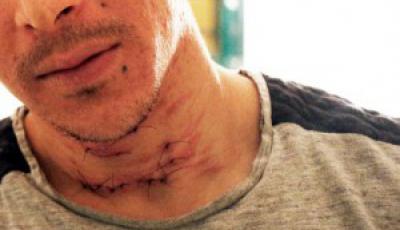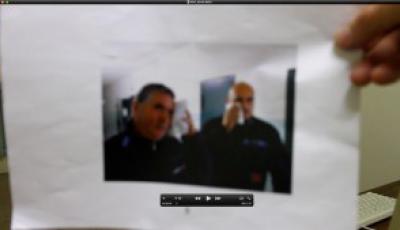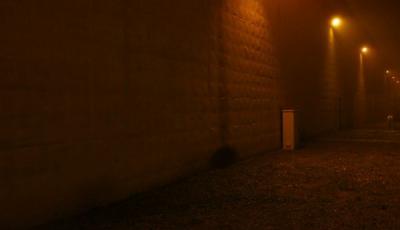The Use of Force Inside a Special Hospital: Photo-elicitation and Qualitative Interviews in the Ethnographic Field
Posted:
Time to read:
Guest post by Luigi Gariglio, University of Turin, and Academic Visitor at the Centre for Criminology
This post is about the fluidity of the research process inside a custodial institution and underlines the necessity to integrate qualitative methods with visual methods in order to adapt to the research site, to grasp the multifaceted and complex realities of it and to enter the actual day-to-day working practices.
Of other Forces
The aim of this research was to study the power relations between prison officers and medical staff on the only closed wing of a “different” custodial institution: a forensic psychiatric hospital (Ospedale Psichiatrico Giudiziario). A special hospital, originally designed to be a maximum security prison in which patients not guilty by reason of insanity, and very violent or diminished capacity inmates are kept in custody cells by prison officers. In the initial stage of the fieldwork, the relevance of the use of force was not immediately evident to me. After the first two months, though, the relevance of it began to emerge, taking shape during the initial stage of my participant observation on the maximum security wing of the ‘hospital’ called Centauro. During my fieldwork I (just like each single person working or kept inside) was continuously exposed to a very heavy and harsh physical setting characterised by heavy filth, little natural light, a lot of cigarette smoke and often by a high level of noise, which was more than what I experienced in many other European custodial institutions, I had visited before. A custodial environment in which, as I discovered during my field work, the social reality was characterised by sui generis individual conducts, behaviours and social interactions and, in which the use of force among all parties was very visible yet not enough problematized.

How to unpack abnormality? Limits of ethnographic research in custodial research
During the first six months I undertook participant observation and shadowed a few officers. Using these techniques, I was able to observe conduct, behaviour, interactions, environments and people. Furthermore, I had learned that I could describe my observations by adopting the “poetics of authoritative accounts” (in Paul Atkinson’s words) that are often used in ethnography. The data I gathered through participant observation was all 'experientially real' (Lawrence Wieder) During fieldwork, in fact, I collected my observation on the different patterns of use of force through my presence in the field. During my observations, I witnessed some ‘critical events’ such few harsh fights between inmates and/or patients in prison yard and a group of officers using force to send a man back into his cell against his will after a psychiatric visit at the infirmary. Furthermore, through interviews in the field, (called ethnographic interviews) I obtained some narratives of critical episodes mainly by covert informants such as educators, nurses, and few officers.
I found it very difficult to unpack the abnormality of what I observed (and experienced with my own body) by using just field notes and ethnographic interview notes. In fact, I realised that in order to grasp the complexity of what I was observing, I needed to find an entirely new approach. However, I also had to consider the advantages of a thick ethnography, such as very good access to the field and high levels of trust. The ethnographic approach actually enabled me to enter the field’s ‘everyday’, and each day in a different way. In fact, I was able to gain some very useful information about the aforementioned critical episodes. Furthermore, the ethnographic interviews allowed me to discover a progressive diminished usage of force (still very frequent nowadays) and, a growing degree of accountability (however still very low at the moment) over the last twenty years.
And yet, little self-reflexive opinions emerged through my methodology. When I tried to shift to some sensitive issues, officers and nurses would very quickly change the topic or slip away to ‘their duties’. Day-to-day activity, interactions were limited to small-talk, banter, jokes, and more importantly to boredom and silences, on one side, and “normal” critical events on the other. In light of the difficulties of grasping the sense of what I had become interested in –the use of force -I decided to add qualitative interviews, I prepared a list of open questions on particular topics to gain better insight into my new issue. I felt some staff’s reluctance to answer my questions openly. These questions were not directly touching upon the use of force, of course, but were related to it, for example, better ways to manage a wing or, more precisely, ‘what do you think of the prisoners' rehabilitation program?’, or ‘what do you think about this wing's regime?’. Despite these very open and ‘easy’ questions, some officers remained uncooperative, closed up and unwilling to talk in depth about the use of force. They rarely mentioned it and when I tried to push in that direction, the interview would abruptly come to an end. However, some officers had apparently no problem to continue performing their tasks, often using force in various ways and to different ends, in front of me, mainly responding to inmates’ provoked critical events or to patient acting out. When asked about it, they justified their behaviour by drawing on routine and informal norms and discipline; if I didn’t ask about it, they simply didn’t care about it at all.
To new Insights with Photo Elicitation

I thought that this particular image and others I had taken could help to introduce the ‘use of force’ from a very different angle to a video-recorded set of interviews with fellow officers. Therefore, I prepared a further nine images (for other images see here). Indeed these images worked as “can opener” (in John Collier’s sense): By simply explaining the image, this visual tool allowed participants to discuss issues such as death, self-harm and assault. These images, prompted participants (prison officers, medical staff and kept) to tell me things I wouldn't have ever dared to formulate in words. The image depicting the aftermath of an officer's assault (Image n. 3), for instance, triggered some of the officers to talk about and to reflect on assaults, violence, their own (or their colleagues) “misbehaviour”, “provocations” towards inmates and the use of force as well as of their vulnerability and very low level of safety at work. Furthermore, photo elicitation worked very well to introduce qualitative interviews. This positive development took me by surprise; I had used photo elicitation on different occasions before, but I had never really experienced the deeper meaning of Merton's idea of serendipity, in other word, suddenly observing an unexpected strategic datum that can lead to new path in the research. I am only starting to get a real sense of it now, whilst working in the field by day and often with Nvivo by night.
Keywords:
Share:

